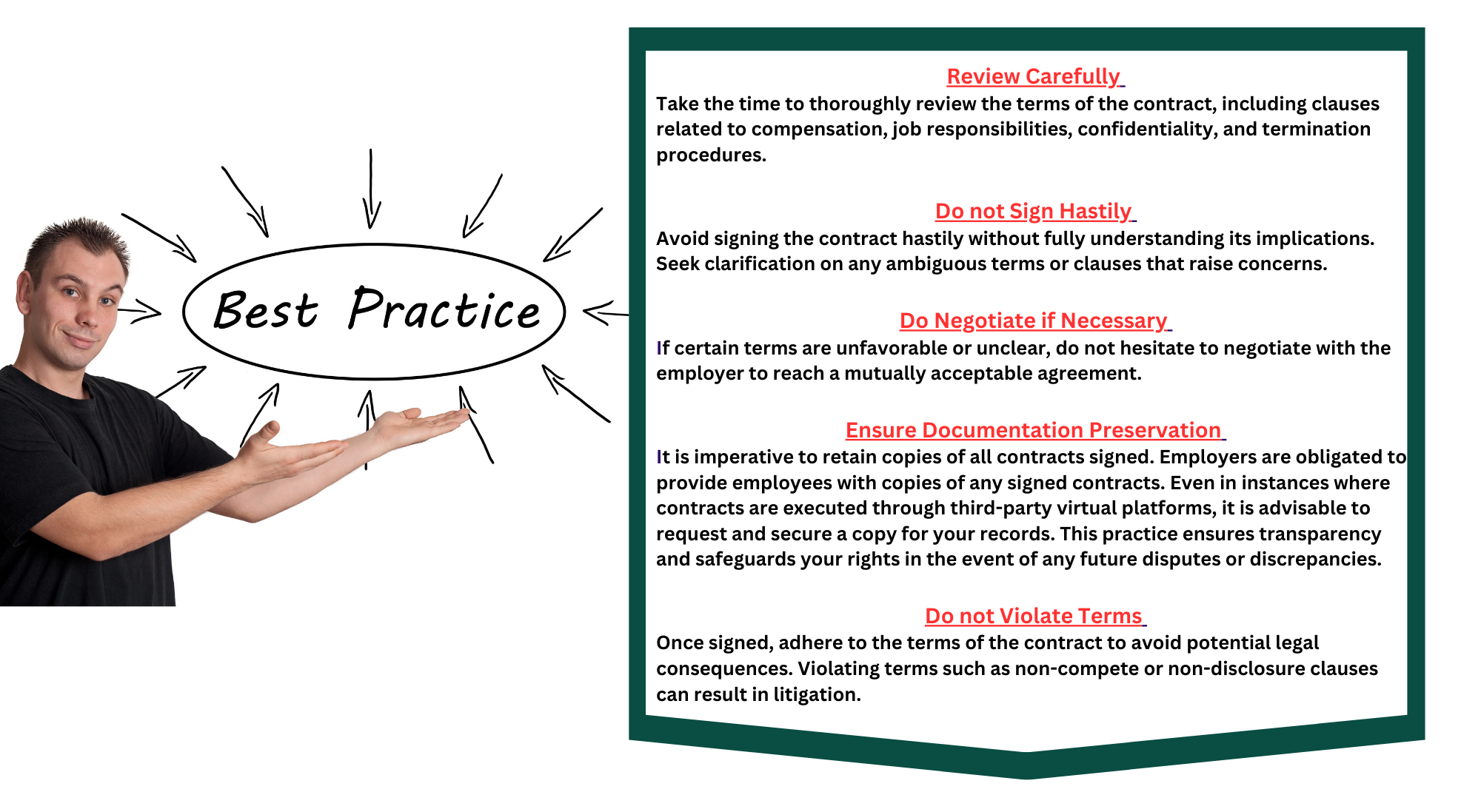Employment Contracts
Employment contracts serve as the foundation of the employer-employee relationship, delineating rights, responsibilities, and expectations for both parties involved. These contracts assume various forms, each carrying its implications and considerations. Mastering the nuances of employment contracts is paramount for employers and employees alike to foster equitable and mutually beneficial agreements.
Categorically, there exist three primary types of Employment contracts, each delineating distinct employment arrangements. Predominantly, Permanent contracts emerge as the ubiquitous form, wherein an employee is engaged for an indefinite period. Encompassing crucial details such as compensation structures, benefits packages, delineated job roles, and procedures for termination, permanent contracts often bind employees to their terms with minimal room for negotiation. Conversely, fixed-term contracts present a contrasting scenario, stipulating a preordained cessation date for employment. These contracts find frequent application in scenarios necessitating seasonal labor, project-specific engagements, or interim staffing solutions.
Lastly, freelance/independent contractor agreements delineate engagements on a project-by-project basis, with the contracted individuals not falling under the classification of traditional employees. These agreements meticulously outline the project scope, remuneration modalities, and intellectual property considerations.

Key Components That May be Contingent to Your Employment Contract
Non-compete agreements are clauses that restrict employees from working for competitors or starting a competing business for a certain period after leaving their current job. While these clauses aim to protect employers' interests, they must be reasonable in scope and duration to be enforceable. As of 2023, more than twenty states have placed restrictions or outright prohibitions on the enforcement of non-compete agreements in certain situations, such as bans against no-poach agreements, non-solicitation agreements, and all traditional non-compete agreements with employees who earn less than $100,000 annually [(1) 2023 Noncompete Landscape (natlawreview.com)].
These states aim to balance the interests of employers in protecting their business interests with the rights of employees to pursue gainful employment. While the specific laws and regulations may vary, some states are known for having particularly stringent limitations on non-compete agreements, while others may enforce them more liberally or with certain conditions. Here are a few states where non-compete agreements are restricted or not allowed:
California is perhaps the most notable state with strong limitations on non-compete agreements. Generally, California law prohibits non-compete agreements except in limited circumstances, such as in connection with the sale of a business.
North Dakota has specific statutes that limit the enforceability of non-compete agreements for employees. These limitations include requiring the agreement to be reasonable in duration and geographic scope.
Oklahoma has laws restricting the enforceability of non-compete agreements, particularly for certain professions like physicians.
Montana law places significant restrictions on the enforceability of non-compete agreements and in many cases are not recognized, particularly for low-wage workers and in situations where the agreements would restrict employee mobility.
Washington state has laws that limit the enforceability of non-compete agreements for employees earning below a certain threshold and those who are terminated without cause.
New Mexico has statutes that limit the enforceability of non-compete agreements, particularly for healthcare professionals.[ (2) No Exit: Understanding Employee Non-Competes and Identifying Best Practices to Limit Their Overuse | ACS (acslaw.org) ]
(It is essential to consult with legal counsel or refer to the specific statutes and regulations in each state to understand the precise limitations and exceptions regarding non-compete agreements. Additionally, the landscape of employment law is subject to change, so staying informed about updates and developments in these areas is crucial for both employers and employees.)

Non-disclosure agreements (NDAs) serve as vital safeguards, meticulously crafted to shield confidential information exchanged between employers and employees throughout the tenure of employment. Under the purview of these agreements, employees undertake a solemn commitment, explicitly barring them from divulging or exploiting sensitive data for personal enrichment or to the detriment of their employer's interests. Furthermore, in scenarios where employment is terminated or disputes arise, it is customary for companies to mandate the execution of NDAs as part of settlement or severance arrangements, ensuring the continued preservation of proprietary knowledge and trade secrets.
Severance contract agreements outline the terms under which an employee will be compensated upon termination of employment. These agreements may be negotiable or non-negotiable depending on the company and include severance pay, continuation of benefits, and provisions regarding non-disparagement and confidentiality. Severance packages vary widely depending on factors such as industry norms, company policies, the level of the employee, and the circumstances surrounding the termination. While each severance package is unique, several common elements contribute to their composition.
Severance pay is the most recognizable component of a severance package. It typically consists of a lump sum payment, or a series of compensation disbursements based on the employee's salary, length of service, and any contractual agreements. Continuation of Benefits by employers may offer to extend health insurance, dental coverage, life insurance, or other benefits for a specified period following termination. The duration and extent of continuation coverage can vary significantly.
Outplacement services in some companies provide outplacement assistance to help terminated employees transition to new employment opportunities. This may include resume writing assistance, job search support, career counseling, and access to networking resources. Vesting of stock options or equity If the employee holds stock options, restricted stock units (RSUs), or other equity-based compensation, the severance package may include provisions for accelerated vesting or the extension of post-termination exercise periods.
Retirement benefits may be offered by the employer to enhance retirement benefits as part of the severance package, such as accelerated vesting of retirement contributions or additional contributions to retirement accounts. Non-financial considerations, in some cases, employers may include non-financial elements in the severance package, such as positive references, career coaching, or the opportunity to retain company-owned equipment or devices. Severance packages typically include a legal document known as a waiver and release agreement, in which the employee agrees to release the employer from any legal claims in exchange for the benefits provided. In rare situations, consulting arrangements can be provided by the employers to employees who were terminated.
This allows the terminated employee to continue collaborating with the company on a consulting basis for a defined period, providing additional income and a smoother transition out of the organization. These elements, among others, contribute to the overall value and comprehensiveness of a severance package. The specific components included will depend on several factors and negotiations between the employer and the terminated employee.

Unenforceable Employment Contracts
Employment contracts may not be upheld in certain situations, primarily when there are legal violations or breaches of a contract by either party. If any provisions of the employment contract violate state or federal laws, such as labor laws or anti-discrimination laws, those specific terms may be deemed unenforceable. Similarly, contracts containing unconscionable clauses—terms that are extremely unfair or one-sided—may be invalidated by a court. In instances of fraud or misrepresentation during the contract negotiation process, the contract may be voided. For example, if an employer falsely promises job security or benefits to induce an employee to sign the contract, the contract may not be upheld.
A material breach of an employment contract occurs when one party fails to fulfill a significant obligation outlined in the contract. If an employer fails to pay wages as agreed upon or if an employee breaches confidentiality obligations, it could lead to the contract being terminated or legal action being taken. For a contract to be valid, there must be an exchange of consideration—something of value exchanged between the parties. If one party fails to provide consideration (e.g., salary, benefits) as promised in the contract, the contract may be invalidated.
Contracts may be voidable if one party was under duress, coercion, or undue influence at the time of signing. For instance, if an employee was pressured into signing the contract under threat of termination, they may have grounds to void the contract.
Take note that employment contract claims are subject to statutes of limitations, which prescribe the time within which legal action must be taken. If a claim is brought after the statute of limitations has expired, the contract may not be enforced. If one party waives their rights under the contract without the other party's consent, it may impact the enforceability of certain provisions. However, waivers must be clear, voluntary, and made with full knowledge of the rights being waived.
In summary, employment contracts may not be upheld in situations involving illegal terms, fraud, breach of contract, lack of consideration, duress, statutes of limitations, or waiver of rights. Both employers and employees need to understand their rights and obligations under the contract to avoid disputes and potential legal challenges.

Determining the exact frequency of companies breaching contracts with employees can be challenging as it depends on numerous factors such as industry, size of the company, and regional legal frameworks. However, breaches of employment contracts do occur, ranging from minor violations to more serious infractions like wrongful termination or non-payment of wages.
Unfortunately, there is not a comprehensive database that tracks every breach of contract by companies. However, assorted studies and surveys shed light on the prevalence of contract breaches and employment disputes. Organizations like the American Bar Association (ABA) and the Society for Human Resource Management (SHRM) regularly conduct surveys on employment practices and legal issues. These surveys often include questions about contract disputes and breaches.
Regrettably, some industries may be more prone to contract disputes than others. For instance, sectors with high turnover rates or intense competition might see a higher incidence of contract breaches. Reports from industry-specific associations or consulting firms may provide insights into common employment issues within those sectors. Government agencies responsible for labor oversight and enforcement may track complaints and disputes related to employment contracts. However, the availability and granularity of such data may vary depending on the jurisdiction.
Given the sensitive nature of employment contract disputes, many cases are settled privately through negotiation, mediation, or arbitration, without formal legal action. Consequently, the true extent of contract breaches in the employment context may be underreported in official statistics. While specific statistics on contract breaches may be elusive, it is clear that disputes over employment contracts are common. Employers and employees alike should prioritize clear communication, diligent contract drafting, and initiative-taking resolution of disputes to mitigate the risk of breaches and foster a positive work environment.

Employment Contracts and Civil Mediation
Employment contracts often assume a pivotal role in civil mediation, an alternative dispute resolution method aimed at resolving conflicts outside the courtroom. It is customary for prominent corporations to incorporate mandatory mediation clauses into their contracts, stipulating that unresolved disputes undergo mediation proceedings before escalating to arbitration. This strategic approach not only curtails legal expenses but also ensures confidentiality, shielding sensitive matters from public scrutiny. Mediation serves as a conducive platform for all parties involved to voice their grievances, seek common ground, and collaboratively forge mutually agreeable resolutions. A myriad of employment-related disputes, spanning breach of contract, wrongful termination, and discrimination claims, find amicable resolutions through the mediation process.
The American Arbitration Association (AAA) attests to the significant role of mediation in settling employment disputes, with a notable portion of such conflicts finding resolution through this avenue. While precise statistics may vary, empirical evidence underscores mediation's efficacy in expediting resolutions and curbing costs compared to traditional litigation channels.
Employment contracts are not static documents but dynamic frameworks that shape the employer-employee relationship. Mastery of their nuances, coupled with adherence to best practices and legal considerations, is indispensable for fostering equitable agreements and resolving disputes amicably. In an ever-evolving landscape, informed negotiation, proactive legal counsel, and recourse to alternative dispute resolution mechanisms like mediation pave the path toward fair and sustainable employment practices.